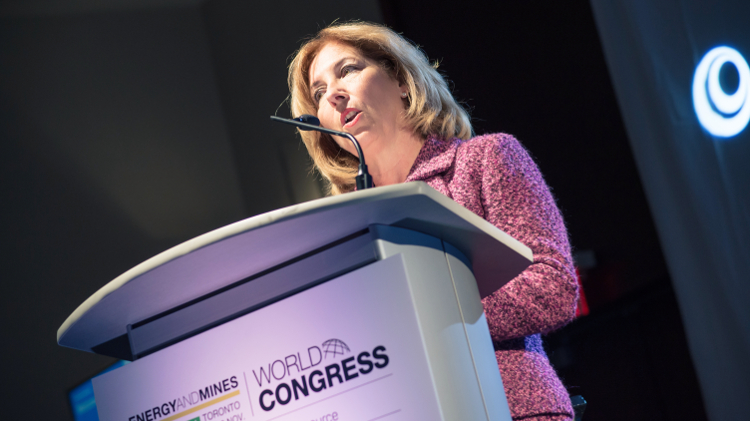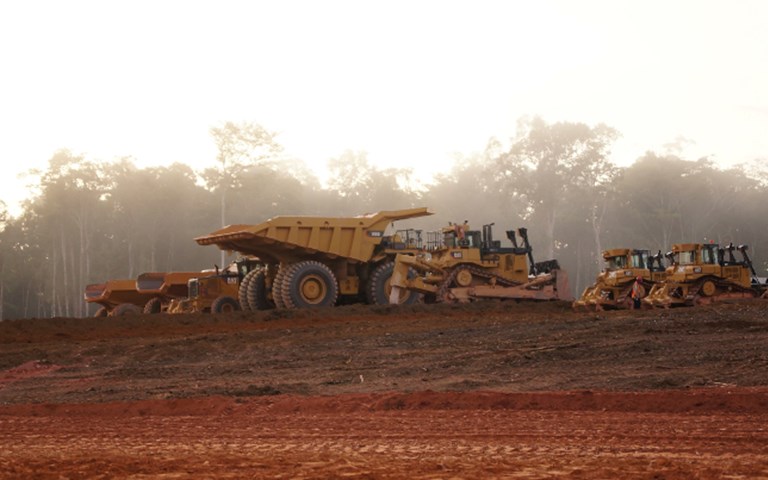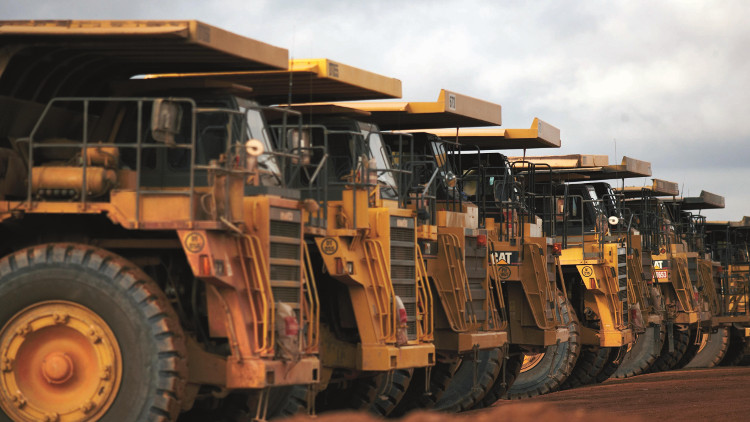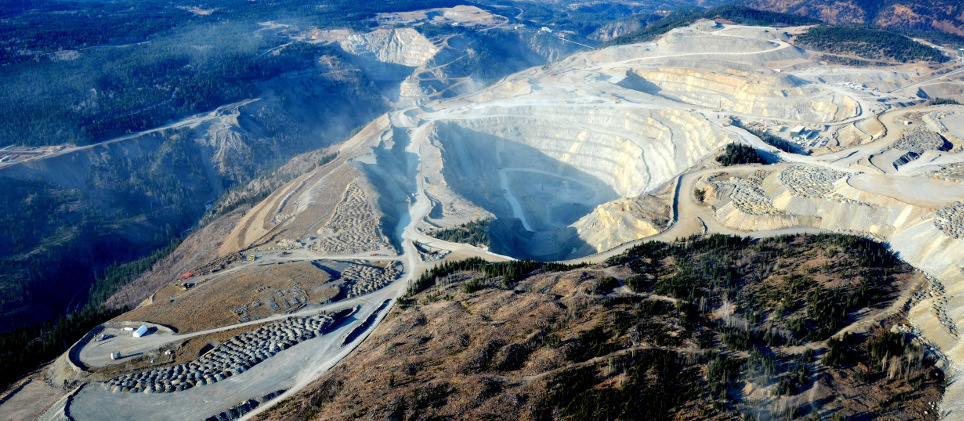Carbon emissions know no borders and reductions in one area of the world are meaningless if there are increases elsewhere. Courtesy of Newmont Mining Corporation
Among all the expenses under the watchful eye of Copper Mountain president and CEO Jim O’Rourke, carbon is one that sticks out as potentially the least useful. He runs a mine with cash costs of $1.54 per pound of copper, so the $2.3 million dispensed to the provincial government every year in the form of a carbon tax represents about 1.5 per cent of his total budget. That cost is set to rise to $3.8 million a year by 2020 under Justin Trudeau’s new pan-Canadian carbon price framework. This is a significant expense that all Canadian miners will soon have to tuck into their annual budgets, but does it have the potential to do good for the industry?
“The problem I have with the carbon tax, generally, is that we can’t do anything about it,” said O’Rourke. Copper Mountain, he pointed out, is an open pit, low-grade copper mine that relies on diesel fuel to bring ore to the mill. “We’ve got 22 trucks running around and we burn about 30 million litres a year of diesel. To try and reduce our carbon footprint is not easy.” Copper Mountain does not see those millions invested improving the carbon footprint-reduction technology in the mining industry, meaning the mine sees no upside to carbon reduction for the expense under the current system.
And though hauling is going to be diesel-driven for a while to come, there are already ways to make the process more efficient. “To give you a good benchmark, a new engine for a truck is about a half a million dollars,” said O’Rourke. “So if we clawed back that $2 million [carbon tax], we could buy four high-efficiency engines for the trucks.” If new Tier-4 engines could save Copper Mountain five per cent of its diesel budget, the mine would save 1.5 million litres a year in fuel, and an additional $115,000 a year in carbon tax paid on diesel. None of that is happening now. “It’s just another tax, in the true sense,” O’Rourke lamented.
And even if Copper Mountain could replace 22 truck motors, then what? With the carbon tax in British Columbia set to grow significantly, there are few ways the miner could feasibly reduce emissions much further. David Greenall, a sustainability and climate resilience strategist at PricewaterhouseCoopers (PwC), said this is why policy decisions have to be made carefully. “I think one of the things is recognizing these inherent limitations, recognizing that these are trade-exposed industries, they’re selling their commodity on a world market, they are price-takers versus price-makers. And that is where the role of active engagement with government is important, around essentially cushioning the transitional effects and risks.”
Last April, the Mining Association of Canada (MAC) came out in favour of a carbon price to address climate change, under certain conditions. But, from the point of view of MAC’s president and CEO Pierre Gratton, as the rest of Canada develops its national strategy it would do well to look to British Columbia for what not to do. That is why Gratton wrote in a Vancouver Sun column last autumn that the result of a tax like the one in British Columbia is that, in terms of mining, “Jurisdictions that take action on climate change are punished, while those that do not are rewarded with jobs and investment, and climate action is stymied.”
The global picture
Carbon emissions are a truly global phenomenon – gasses know no borders and reductions in one area of the world are meaningless if there are increases elsewhere. But aside from parts of Canada, there are not many mining jurisdictions that currently have any sort of carbon price implemented. Within Canada’s borders, Alberta, Ontario, and Quebec join British Columbia as provinces that currently have some form of carbon pricing in place. Unsurprisingly, the jurisdictions outside Canada that have a price include Sweden and Finland, but other joiners are hard to find.
This potentially makes less stringent jurisdictions more attractive for investment and results in something called “carbon leakage,” where instead of reducing emissions, operations are moved to other locations and, in some cases, emissions are increased. “The stakes are high in the sense that, unless [Canada’s] policy addresses this concern, then a) climate change will not be addressed, and will potentially result in a net increase in emissions and b) the policy could harm a significant engine of the Canadian economy,” said Brendan Marshall, MAC’s vice-president of economic and northern affairs. “That’s a lose-lose situation.”
Another side effect of imperfectly applied carbon pricing can be political blowback. Back in 2012, Australia passed the Clean Energy Act. “This was the first major legislation imposing a carbon tax on energy use,” recalled Omar Jabara, corporate communications executive with Newmont. But in 2014 the legislation met its end amid heated debate. The tax was initially set at a rate of A$23 per tonne, a modest amount, but was repealed because of the economic impacts. Carbon emissions in Australia have since risen.
The wide range of carbon pricing makes less stringent jurisdictions more attractive to investment, resulting in "carbon leaking". Courtesy of Newmont Mining
But a number of carbon pricing schemes are on the way in, most notably in China, which produces about 23 per cent of the world’s carbon dioxide. “Our biggest market is China and they plan to implement a nation-wide carbon trading scheme,” said Graham Winkelman, climate change practice lead at BHP Billiton. “This significantly increases the amount of global emissions that are covered and we watch with interest to see how it will play out.”
Parts of China have been involved in pilot carbon trading markets since 2013, but the nationwide program will meanup to US$1.16 billion in carbon trading annually starting this year. That is with a relatively modest price of about 30 yuan per tonne (US$4.35) at the outset, and the market is expected to grow to up to US$58 billion after 2020.
Chile is also moving forward with a carbon price in 2018, though with a modest US$5 per tonne initial price. Nevertheless, this price has the potential to affect 30 per cent of the world’s copper production and perhaps offer some market support for Copper Mountain. “The reality is that we are in a low carbon transition,” said PwC’s Greenall. He said carbon pricing will affect mining both at the operational level, with technological solutions, and at the demand level. “The demand question is a much bigger kind of question.”
The variation in pricing across the globe is an issue, said BHP Billiton’s Winkelman. “The ideal solution over time is a global price on carbon, but that’s a very challenging thing to get right.” He emphasized that, since miners need to look decades in the future to make their business decisions, it is important that climate regulation be stable and predictable. Because all countries have different strategic objectives, he said, they will go about reducing their carbon footprint in different ways. For example, though the United States has no carbon price in place, the Obama administration had shifted to regulating emissions from coal-fired power stations. Essentially, each nation that signed the Paris Agreement last April needs to find its own path to decreasing emissions. “Gaining alignment in some sort of global view is really challenging.”
Internal pricing
BHP Billiton is, according to a 2014 report by the Heinrich Böll Foundation, responsible for the 20th largest carbon budget of any company in the world. With the demerger of South32 in 2015, BHP Billiton operates a smaller portfolio now than it did in 2014, but the company has the incentive and the means to aid in the development of a global carbon price. Internally, Winkelman said the company currently models a price of US$24 per tonne of carbon regardless of the location of the project, though he added, “It’s not just one price that we have in mind – we also think about future pricing scenarios.” Consequently, the company evaluates all of its assets considering carbon prices ranging up to US$80 per tonne.
It is a strategy that Greenall believes is going to be more widely adopted in the future. “This is just another what I call ‘risk factor.’ A pretty big risk factor, potentially. But it’s just another risk factor that gets internalized into the kinds of modelling that these companies already do.”
Greenall also said that beyond simply modelling a price internally (BHP Billiton applies what he calls a “shadow price”), companies can actually set up internal carbon markets between business units. There are many ways to set this up but, for example, each mine could set emissions reduction targets and if the target emissions are exceeded, each tonne of carbon over the goal would result in a penalty paid by that operation to head office and perhaps cuts to bonus pay for executives at that mine. “That’s a direct cost to that operation’s profitability, which of course then gets tied back into individual performance metrics and bonuses, et cetera.”
According to a 2016 report from the Carbon Disclosure Project (CDP), 35 per cent of companies that responded to a survey in the materials sector are already internally pricing carbon, or are planning to. In Canada, those currently pricing carbon include HudBay, Teck Resources and Barrick Gold, with Detour Gold and Yamana Gold planning to price carbon in the next two years. However, the worldwide variance in internal price hints at how difficult it will be to set up a global carbon price. For example, South Africa-based Sibanye Gold prices carbon at US$2.36 per tonne whereas BHP Billiton uses a price more than ten times that, and HudBay uses a range of prices between US$15.32 and US$38.29.
The most advanced internal pricing schemes are possibly in the oil and gas sector, where Royal Dutch Shell has been tying executive bonuses to climate-related goals. In the energy sector overall, 52 per cent of respondents to the CDP questionnaire currently price or plan to price carbon, which is topped only by the utilities sector with 63 per cent.
“There’s a real appetite for information in the investor community,” said Winkelman, who added that at the time BHP Billiton started reporting carbon emissions and pricing them, there were not many examples to follow in mining. “We looked across everything from how the banking sector through to oil and gas and manufacturing were reacting, along with governments. This is going to be characteristic of the way many large companies communicate going forward. It’s all about opportunity, not just about risk.”
Greenall said BHP Billiton is definitely a leader in the field, having had an internal carbon price since about 2004. “They were first out of the gate and so they are kind of a lightning rod for both investors and other companies as they look for examples to try and figure out how the heck they do this.”
Finance sector on alert
In addition to internalizing a price on carbon, BHP Billiton is one of the few mining companies to publish a yearly climate change portfolio analysis. The report is a rational summary of how the company plans to act under a variety of very plausible different global policy, environmental and economic outcomes. Their report provides the kind of information that investors are looking for. “I’m certain as we go forward the richness of information will increase,” said Winkelman.
A consistent way to structure these kinds of reports is now beginning to take shape. In December, Michael Bloomberg wrote to Mark Carney: “until now, it has been difficult for investors to know which companies are most vulnerable to climate change, which are best prepared, and which are taking action.” Bloomberg’s letter was the introduction to a list of recommendations by the Task Force on Climate-Related Financial Disclosures, of which he is the founder. And, as Carney is the chair of the Financial Stability Board, these recommendations are likely to have a significant impact worldwide.
Copper Mountain's $2.3 million in annual carbon taxes to the provincial government represents 1.5 per cent of its yearly budget. Courtesy of Copper Mountain Mining Corporation
“The Financial Stability Board is essentially all of the Central Bank governors of the G20,” said Greenall. “I can tell you with absolute certainty that many of Canada’s largest pension funds and banks will be adopting the recommendations of the Task Force and thus requiring the companies in which they invest and do business, either on the public or private equity side of their line, to make this information available.”
The actual recommendations are too detailed to list here, but included is specific guidance for mining and other sectors that account for the largest proportion of GHG emissions, energy use and water use.
As far as implementation, “I don’t believe we’ve seen a shareholder resolution here in Canada,” said Greenall. “But in the last year there have been a number, principally targeted at oil and gas majors – BP, Total and Royal Dutch Shell – asking them to just prepare a climate risk scenario analysis report.”
For Copper Mountain’s O’Rourke, perhaps this can serve as a consolation: it would seem only a matter of time until miners are obligated, whether their operations are in Canada or anywhere else, to disclose how they value carbon in order to garner investment. What is less certain is how, when carbon moneys are actually collected, they will go towards creating a stronger industry for the future.
“I think it’s challenging,” said Winkelman. “But when we think of how a carbon price can potentially steer investment towards lower emissions outcomes, which over time will become cost effective, I think that’s a positive outcome for the industry, while at the same time contributing to addressing climate change. The mining industry has a real role to play in the solution.”
*****
This was one of our favourite stories of the year. To see the full list, check out our Top 10 of 2017 editors' picks.






